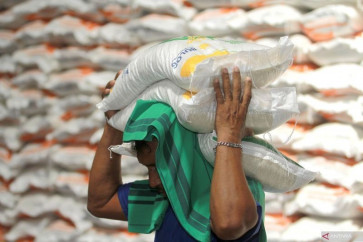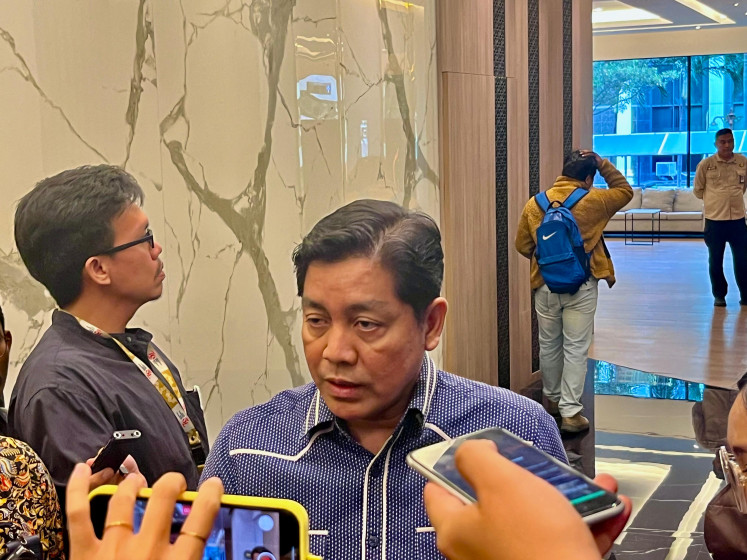Popular Reads
Top Results
Can't find what you're looking for?
View all search resultsPopular Reads
Top Results
Can't find what you're looking for?
View all search resultsBATAK ‘ULOS’- Paving the way for world recognition
Handmade: Several women wearing ulos traditional garments welcome guests to celebrate Ulos Day 2016 in Medan, North Sumatra, in October
Change text size
Gift Premium Articles
to Anyone
Handmade: Several women wearing ulos traditional garments welcome guests to celebrate Ulos Day 2016 in Medan, North Sumatra, in October.
Ulos finds a way to survive in the modern era while retaining its high value in the Batak tradition.
Retta Siregar was adeptly operating a weaving loom to produce ulos, the Batak ethnic group’s traditional cloth to be worn over the shoulders. She showcased her multitasking skills by demonstrating speedy ulos making while chatting, and drawing the admiration of visitors to the recent Ulos Day commemoration event in Medan, North Sumatra.
The woman who hails from Tarutung, North Tapanuli, North Sumatra, describes the process of ulos making as difficult and time-consuming.
“A piece of ulos takes between one to three months to finish, depending on its motifs,” she told The Jakarta Post.
Retta, who has 18 years of weaving experience, said the length of time and intricate work involved made the market price of ulos high. She mentioned that the lowest price of ulos today started at around Rp 800,000 (US$60) per piece and the highest price could fetch over Rp 3 million.
“The more complicated its motif, the more expensive it will be,” she said.

Various ulos motifs
Ulos motifs are varied with different colors, names and uses. In North Tapanuli combinations of white, red and black are more dominant, while in South Tapanuli there are four main colors adorned with white and black beads. The base color in Karo is dark blue while in Toba and Simalungun it is brownish black or white.
Ulos weaving begins with refining the yarn to be woven, followed by reeling the yarn and then designing the basic form of ulos. After that, the yarn is spread over the loom for ulos cloth weaving.
During the Ulos Day celebration, the audience could see more than a dozen types of ulos creations within their respective names. Each type has its own meaning and purpose. Ulos Bintang Maratur, for instance, symbolizes joyfulness. It is frequently used during North Sumatra’s Batak traditional wedding receptions where relatives will present the ulos to the wedding couple or parents who are hosting the party.
Ulos Ragihotang often serves as a wedding gift, but lately it has been mostly used as a shawl. Ulos Sibolang Rasta is used for mourning purposes. Its name changes to Ulos Tujung if the bereaved wife or husband using it has no grandchildren, and it becomes Ulos Saput if the bereaved has no grandchildren and their children are underage.
Batak community figure Wilmar Simanjuntak said ulos, originally worn by Batak ancestors to keep their bodies warm, has now become famous and sought after by many people. Two years ago, the government declared the traditional woven cloth part of the nation’s intangible cultural heritage and since then, Oct. 17 had been marked as Ulos Day.
“We as Batak community members feel proud to see ulos growing in popularity. It’s now the opportunity for us to make ulos well known in the world,” Wilmar said during the event.
A number of officials and honorary guests from other countries, such as Thailand, attended the event, which also featured Batak traditional dances, an ulos-motif fashion show and a display of a 500-meter-long ulos by school students.
North Sumatra Governor T. Erry Nuradi hopes ulos will be embraced by world leaders and Hollywood artists. He said ulos did not merely serve as a traditional cloth used during ritual events, but it had evolved to become a part of daily fashion. Various garments had now been combined with ulos like jackets, shirts and gowns, generating more attraction and higher value.
Meanwhile, Deputy Chairperson of the Regional Representatives Council (DPD) Gusti Kanjeng Ratu Hemas hoped that along with the increased fame of ulos in the traditional handicraft market, this cloth and its weavers would receive greater appreciation.
“Appreciation should be extended to ulos and its craftspeople. Ulos weavers and their woven cloth don’t get as much attention as Batak heritage, which is widely reputable,” she said.
— Photos by Apriadi Gunawan










